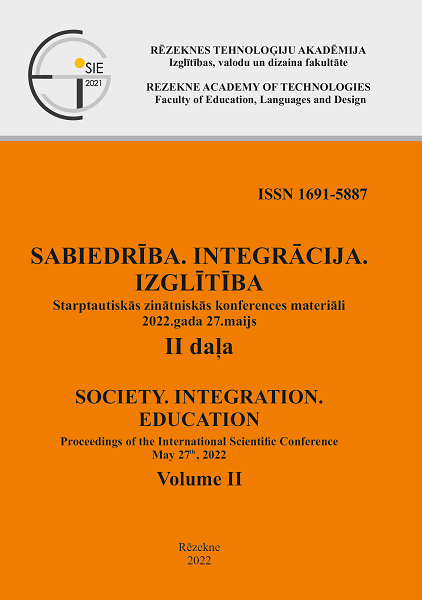DEVELOPMENT AND INITIAL VALIDATION OF THE MULTIDIMENSIONAL SOCIAL CAPITAL SCALE (MSCS)
DOI:
https://doi.org/10.17770/sie2022vol2.6813Keywords:
psychometric properties, reliability, scale development, social capital validityAbstract
Social capital has been studied as one of the most important external resources that contribute to overcoming difficulties of individuals, the ability to adapt and show solidarity in times of crisis, preventive behavior. However, no specific assessment tool has been developed and validated for the measurement of social capital in Latvian. The present study aimed to develop and perform an initial validation of the Multidimensional Social Capital Scale (MSCS) in a Latvian adult sample. The developed theoretical concept based on rapid review covers such types of social capital as bonding, bridging and linking, and there are two dimensions in each of these types: cognitive and structural. Data were collected from a representative sample of Latvian inhabitants (N=1003), within a framework of the National research program “Life with COVID-19” in September 2020. As a result, a four-component structure was obtained. MSCS covers only the cognitive dimension of all three types. One type of bonding (Shared values and perceived social support for family members and close friends), one type of bridging (Perceived social support for friends and acquaintances), and two types of linking (Institutional trust and Attitude towards laws and norms). The items are internally consistent on all scales (Cronbach’s alpha ranged from .80 to .90). Discrimination indices generally meet the scientific requirements falling within the range (.20 – .80). Based on Exploratory (EFA) and Confirmatory factor analysis (CFA) a four-factor structure of MSCS was confirmed (k = 16) in two samples. CFA results demonstrated that the MSCS was a valid and reliable multidimensional scale, which was invariant across both samples. The present findings indicate the validity and reliability of the MSCS for the Latvian population.
Downloads
References
Agampodi, T.C., Agampodi, S.B., Glozier, N., & Siribaddana, S. (2015). Measurement of social capital in relation to health in low and middle income countries (LMIC): A systematic review. Social Science & Medicine, 128, 95-104. DOI: https://doi.org/10.1016/j.socscimed.2015.01.005
Beilmann, M., Kööts-Ausmees, L., & Realo, A. (2018). The Relationship Between Social Capital and Individualism–Collectivism in Europe. Social Indicators Research, 137(2), 641-664. DOI: https://doi.org/10.1007/s11205-017-1614-4
Byrne, B.M. (2001). Structural Equation Modeling with AMOS: Basic Concepts, Applications, and Programming. 1st Ed. Vol. 20. Taylor & Francis. DOI: https://doi.org/10.1207/s15327574ijt0101_4
Carrillo Álvarez, E., & Riera Romaní, J. (2017). Measuring social capital: further insights. Gaceta Sanitaria, 31(1), 57-61. DOI: https://doi.org/10.1016/j.gaceta.2016.09.002
Eagle, D., Hybels, C., & Proeschold-Bell, R.J. (2018). Perceived social support, received social support, and depression among clergy. Journal of Social and Personal Relationships, 36, 026540751877613. DOI: https://doi.org/10.1177/0265407518776134
Ehsan, A., Klaas, H.S., Bastianen, A., & Spini, D. (2019). Social capital and health: A systematic review of systematic reviews. SSM Popul Health, 8, 100425. DOI: https://doi.org/10.1016/j.ssmph.2019.100425
Fukuyama, F. (2001). Social capital, civil society and development. Third world quarterly, 22(1), 7-20. DOI: https://doi.org/10.1080/713701144
Giordano, G.N., & Lindström, M. (2011). Social capital and change in psychological health over time. Social Science & Medicine, 72(8), 1219-1227. DOI: https://doi.org/10.1016/j.socscimed.2011.02.029
Gonzales, E., & Nowell, W.B. (2016). Social Capital and Unretirement: Exploring the Bonding, Bridging, and Linking Aspects of Social Relationships. Research on Aging, 39(10), 1100-1117. DOI: https://doi.org/10.1177/0164027516664569
Guillen, L., Coromina, L., & Saris, W. (2011). Measurement of Social Participation and its Place in Social Capital Theory. Social Indicators Research, 100, 331-350. DOI: https://doi.org/10.1007/s11205-010-9631-6
Hooper, D, Coughlan, J and Mullen, M (2008) Structural Equation Modelling: Guidelines for Determining Model Fit. ElectronicJournal of Business Research Methods, 6(1), 53-60.
Kažoka, I. (2021, January 28). Latvija – joprojām zemas uzticēšanās sabiedrība; iedzīvotāji vēlētos plašākas iesaistes iespējas. LSM.LV. Pieejams: https://www.lsm.lv/raksts/zinas/latvija/latvija--joprojam-zemas-uzticesanas-sabiedriba-iedzivotaji-veletos-plasakas-iesaistes-iespejas.a390701/
Moody, J., & White, D.R. (2003). Structural Cohesion and Embeddedness: A Hierarchical Concept of Social Groups. American Sociological Review, 68(1), 103-127. DOI: https://doi.org/10.2307/3088904
Narayan, D., & Cassidy, M. (2001). A Dimensional Approach to Measuring Social Capital: Development and Validation of a Social Capital Inventory. Current Sociology - CURR SOCIOL, 49, 59-102. DOI: https://doi.org/10.1177/0011392101049002006
Panagiota, K., & Apostolopoulos, C. (2009). Local development using social capital as an instrument: A comparative analysis, 120, 329-338. DOI: https://doi.org/10.2495/SDP090321
Portela, M., Neira, I., & Salinas-Jiménez, M. d. M. (2013). Social Capital and Subjective Wellbeing in Europe: A New Approach on Social Capital. Social Indicators Research, 114(2), 493-511. DOI: https://doi.org/10.1007/s11205-012-0158-x
Rajkumar, R.P. (2020). COVID-19 and mental health: A review of the existing literature. Asian journal of psychiatry, 52, 102066-102066. DOI: https://doi.org/10.1016/j.ajp.2020.102066
Raykov, T., & Marcoulides, G.A. (2010). Introduction to Psychometric Theory (1st ed.). Routledge. DOI: 10.1007/s11336-013-9384-7
Realo, A., Allik, J., & Greenfield, B. (2008). Radius of Trust: Social Capital in Relation to Familism and Institutional Collectivism. Journal of Cross-Cultural Psychology, 39(4), 447-462. DOI: https://doi.org/10.1177/0022022108318096
Rosseel, Y. (2011). lavaan: An R Package for Structural Equation Modeling. J Stat Softw, 48, 1-36. DOI: https://doi.org/10.18637/jss.v048.i02
Shi, D., Lee, T., & Maydeu-Olivares, A. (2018). Understanding the Model Size Effect on SEM Fit Indices. Educational and Psychological Measurement, 79(2), 310-334. DOI: https://doi.org/10.1177/0013164418783530
Sønderskov, K.M., & Dinesen, P.T. (2016). Trusting the state, trusting each other? The effect of institutional trust on social trust. Political Behavior, 38(1), 179-202. DOI: https://doi.org/10.1007/s11109-015-9322-8
Bavel, J.J.V., Baicker, K., Boggio, P.S., Capraro, V., Cichocka, A., Cikara, M., ... & Willer, R. (2020). Using social and behavioural science to support COVID-19 pandemic response. Nature Human Behaviour, 4(5), 460-471. DOI: https://doi.org/10.1038/s41562-020-0884-z
Šuriņa, S., & Mārtinsone, K. (2020). Conceptualization of social capital in cross-sectional design studies: Rapid review of literature. Society. Integration. Education. Proceedings of the International Scientific Conference, 7, 177-186. DOI: https://doi.org/10.17770/sie2020vol7.4973


